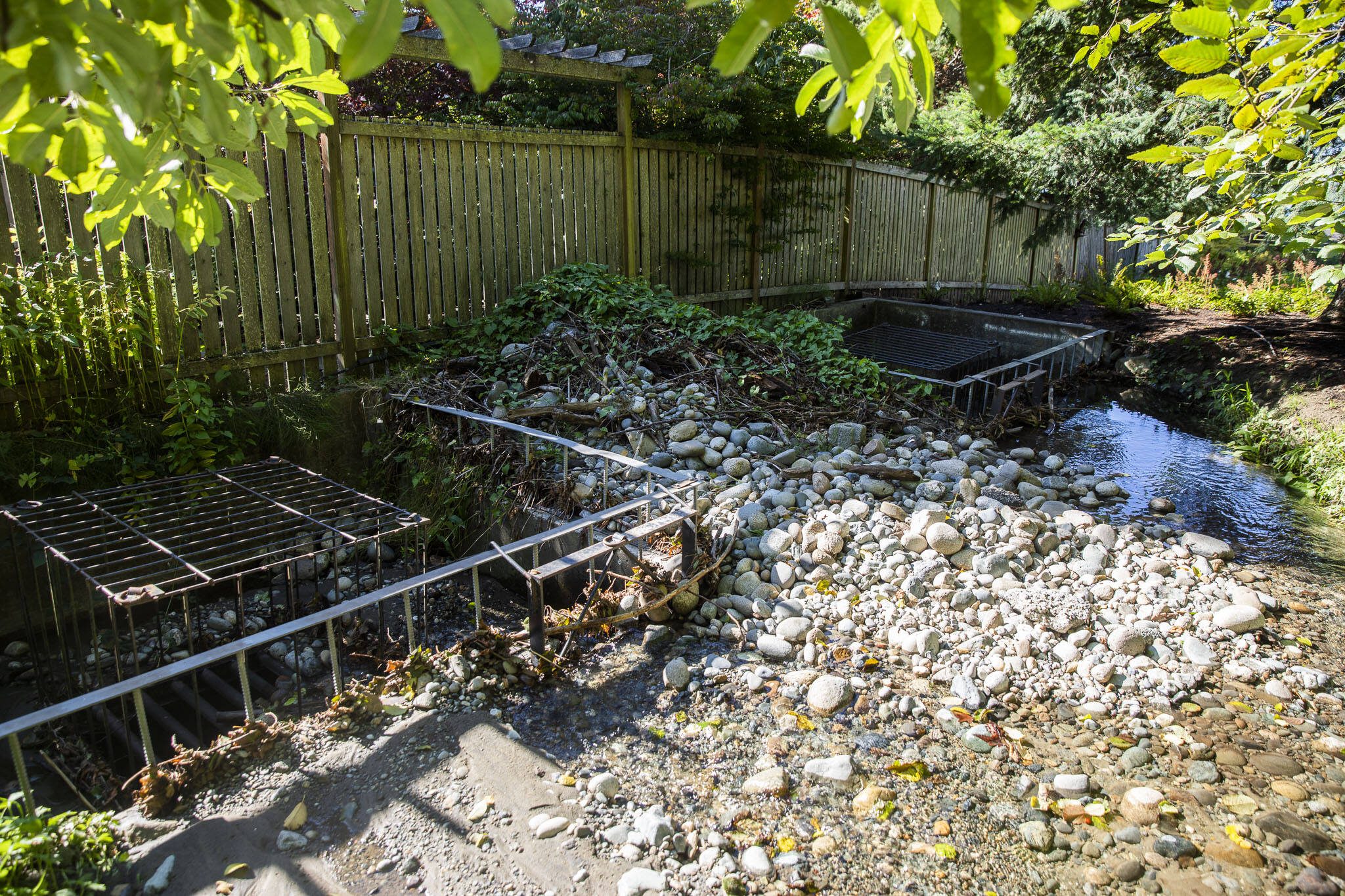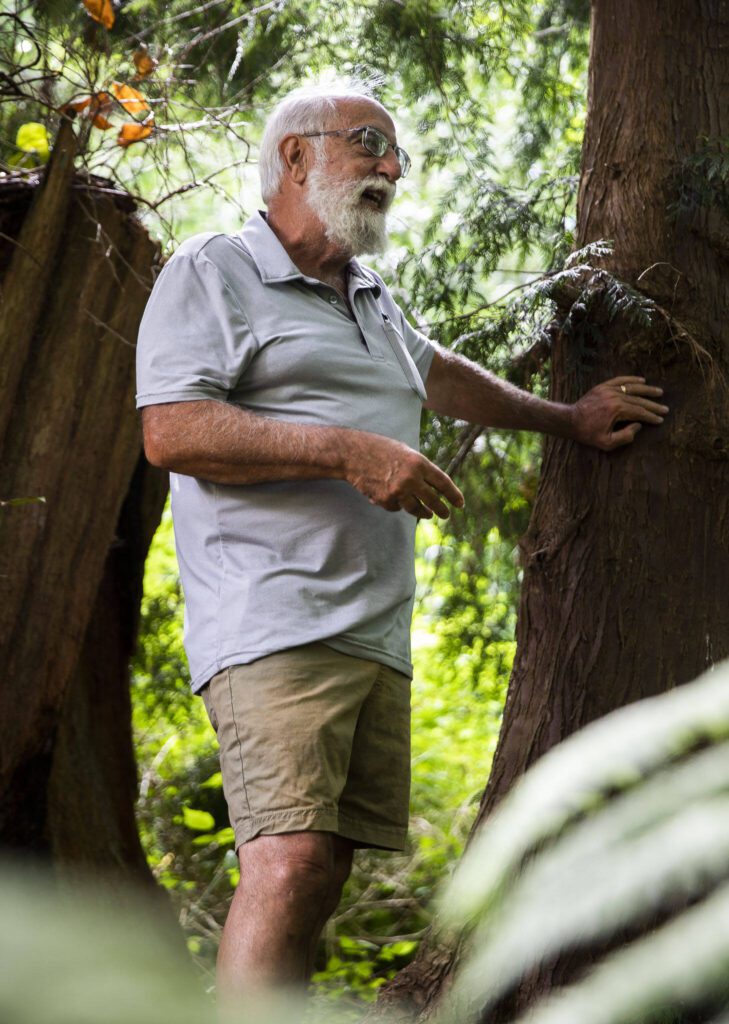EDMONDS — Like countless streams and rivers, Perrinville Creek used to flow directly to Puget Sound, a natural pathway for anadromous fish such as salmon to migrate to and from river and sea, unhampered by man-made structures.
But 40 years ago, homeowners and Edmonds city staff began altering Perrinville’s route. Since then, the small stream has become increasingly difficult for fish to navigate, culminating in city staff installation of a complete flow diversion structure in 2021 that made the last few hundred feet of the creek run through a ductile pipe, making it inaccessible to fish.
The city of Edmonds wants to continue maintaining its flow diversion structure, but the structure was built without proper permits or environmental analysis.
Last May, Edmonds resident Robert Bernhoft appealed the city’s decision that continuing to maintain the creek as is didn’t warrant environmental review or mitigation. He argues that the flow diversion was illegally installed and stops salmon from accessing important habitat.
A hearing in front of Edmonds Hearing Examiner Phil Olbrechts lasted over a period of five days, from Jan. 24 to Feb. 14. On March 7, attorneys for Bernhoft and the city of Edmonds submitted closing arguments. A decision on the case is expected by March 21.
City officials declined to comment for this story, citing pending legal action, spokesperson Kelsey Foster said in an email.
While the case hinges on legal technicalities regarding definitions Washington’s Department of Fish and Wildlife uses for granting permits, the situation involves layers of history revolving around past and present homeowners, city flooding concerns and biologists’ restoration desires.
‘Never-ending process’
In 1984, the city of Edmonds conducted an environmental assessment for a short plat, a type of land subdivision, and approved the construction of a house at 8235 Talbot Road, just south of where Perrinville Creek meets Puget Sound. The city’s approval came with a condition that the homeowners construct a flood mitigation berm, a flat strip of raised land bordering a stream or river, since the area lies within a FEMA flood zone.
But that berm was never constructed, according to court testimony provided by current Lynnwood civil engineer Bill Lider, who has advocated for environmental causes across Snohomish County.
Instead of building the required berm to reduce flooding risk, property owners at 8235 and 8307 Talbot Road in mid-1990s filled parts of the floodplain, creating ornamental gardens and modifying the lower 300 feet of Perrinville Creek, according to Lider’s testimony. Because of the location and lack of precautionary infrastructure, the residents experienced flooding the city of Edmonds constructed a high-flow bypass structure at 8235 Talbot Road in an attempt to prevent future flooding.
The structure, which is still there, includes two concrete storm drain boxes, connected by a 36-inch pipe, which discharges water into an iron pipe that goes under the Burlington Northern Santa Fe railroad tracks before emptying into Puget Sound.
The structure was only meant to accommodate high flows, taking extra water into the pipe so that the downstream houses weren’t flooded, and the surface channel still existed so fish were able to move throughout the creek.
But in 2012, the city added another pipe, allowing more of the stream flow to run into a pipe instead of along the surface. This made it even harder for fish to navigate the stream, and with more water flowing through the drains into the pipe, more debris and sediment would quickly build up, blocking the drains, according to Bernhoft’s closing argument document and Lider’s testimony.
Lider made multiple public records requests, asking to see the city’s documentation of who engineered the new pipe rerouting or conducted environmental and hydraulic reviews. But despite the requests, he did not receive proof there had been environmental analysis before drastically changing the creek’s route, according to the closing argument document.
Over time, because of the extra debris buildup, maintaining the boxes became “a never-ending process,” Edmonds Public Works Director Phil Williams told The Herald in 2023. And in the winter of 2020-21, intense storms overwhelmed the drainage boxes with sediment and water.
During one of the storms, public works employees worked through the night, digging debris out as an attempt to prevent massive flooding.
“City crews worked in very challenging weather and safety conditions for several days and nights trying and keep Talbot Road from washing out and the creek channel open and flowing,” a city document filed in court stated. “In the end, we could not keep up with the incoming volumes of water and sediment and a decision was made to protect downstream residents from further damage by modifying the sediment trap/overflow system to full overflow mode.”
While city staff reached out to the Washington Department of Fish and Wildlife to notify the agency of the changes, they were denied a short-term waiver for the project, and in February, the agency ordered staff to unblock the natural channel.
But since the storms in 2021, the city has not restored the creek’s surface channel.
‘Everybody’s ignoring it’
Another aspect of the case is a deteriorating, city-owned ductile iron pipe that carries the diverted stream under the railroad tracks to Puget Sound. Evidence submitted to the case shows that the pipe has deteriorated so much that large rocks are gaping through the pipe, which has raised concerns about train derailment.
“We’re going to have another train catastrophe like they had in Ohio if we don’t do something about it,” Bernhoft said in an interview on Thursday. “Everybody’s ignoring it. They don’t give a darn one way or the other.”
What’s happening now?
Until February 2024, the city had a Hydraulic Project Approval permit from Fish and Wildlife, which allowed staff to legally remove sediment that piled up at the overflow diversion structure. But Fish and Wildlife granted that permit in 2019, and its specifics didn’t cover the work done after the 2020-21 storms when the city rerouted the entirety of the creek into the pipe.
In 2024, Edmonds began applying for a new permit to maintain the current diversion structure for another three years.
To apply for a new permit, city workers first had to comply with the State Environmental Policy Act, which requires a review of projects that could affect Washington’s environment. After doing their review, city workers decided the continued maintenance wouldn’t have significant negative effects.
Edmonds’ decision means the project could continue without further environmental review. However, Bernhoft is arguing that the review wasn’t properly or thoroughly done, and more environmental analysis should be conducted.
The city’s review states that the permit proposal does not “alter or otherwise affect drainage patterns,” and lists no known threatened or endangered species at the site, even though there’s documented coho salmon and other endangered fish species being found in the creek.
Bernhoft argues that, above all, city taxpayers’ money is going toward maintaining a structure that harms fish, was done without proper environmental review and benefits private homeowners who didn’t originally follow flood-reducing risk conditions.
The city is arguing they did their due diligence and should be able to continue the permit process.
‘Is the existing condition fish friendly? No.’
In March 2021, the city created a preliminary proposal to restore the creek, and Fish and Wildlife granted permission for restoration work to begin. At that time, Joe Scordino, a retired fisheries biologist who has done restoration work in Edmonds and has worked alongside Fish and Wildlife on various projects, got a permit to release coho salmon fry into upper Perrinville Creek.
So in the springs of 2023 and 2024, Scordino and others have released baby coho in the creek with the hope that in 2 years when the fish mature, they can return to the creek to spawn. But if the diversion structure is still in place, fish won’t be able to access their spawning grounds, Scordino said in an interview on Monday.
These fish are going to come into that pipe trying to find their way through and, instead, keep [banging] into a concrete structure,” he said. “Essentially it’s going to kill them, and the city seems to not care.”
The city admitted to the issue in its closing argument.
“Is the existing condition fish friendly? No,” the document admits. “Which is why the City is working with owners and stakeholders to eventually make a better connection between Perrinville Creek and Puget Sound.”
But, in regard to the actual case at hand, the city argues that the question is whether continuing to maintain the diversion structure, which the city believes is the correct baseline condition, causes adverse impacts to fish passage or fish habitat.
“By definition, if the Proposal is merely continuing the baseline condition, there cannot be probable significant adverse impacts for SEPA purposes,” the document said.
If the Hearing Examiner denies the appeal, allowing the city to move forward with its application for continued maintenance, Scordino said he and other environmentalists will appeal the Fish and Wildlife’s decision to grant the Hydraulic Project Approval permit.
“Regardless of what the hearing examiner rules it’s an invalid document,” he said.
Eliza Aronson: 425-339-3434; eliza.aronson@heraldnet.com; X: @ElizaAronson.
Eliza’s stories are supported by the Herald’s Environmental and Climate Reporting Fund.
Talk to us
> Give us your news tips.
> Send us a letter to the editor.
> More Herald contact information.



























